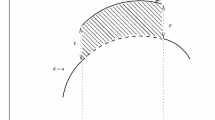Abstract
The fate of optimality modeling is typically linked to that of adaptationism: the two are thought to stand or fall together (Gould and Lewontin, Proc Relig Soc Lond 205:581–598, 1979; Orzack and Sober, Am Nat 143(3):361–380, 1994). I argue here that this is mistaken. The debate over adaptationism has tended to focus on one particular use of optimality models, which I refer to here as their strong use. The strong use of an optimality model involves the claim that selection is the only important influence on the evolutionary outcome in question and is thus linked to adaptationism. However, biologists seldom intend this strong use of optimality models. One common alternative that I term the weak use simply involves the claim that an optimality model accurately represents the role of selection in bringing about the outcome. This and other weaker uses of optimality models insulate the optimality approach from criticisms of adaptationism, and they account for the prominence of optimality modeling (broadly construed) in population biology. The centrality of these uses of optimality models ensures a continuing role for the optimality approach, regardless of the fate of adaptationism.

Similar content being viewed by others
Notes
Understood in this way, the optimality approach also includes game-theoretic models, which are used when trait fitnesses are frequency-dependent. The fitness functions used in game-theoretic models take into account not only the environment, but also the trait values (strategies) of the other members of the population. For this reason, game-theoretic models often do not predict a single optimal trait value, but an optimal distribution of trait values in the population. Some game-theoretic models even predict that there will not be a stable distribution of trait values, but a continual cycle of change (Hofbauer and Sigmund 1998). My points in this paper apply to this broad class of models, for they pertain to all equilibrium models that do not represent genetic transmission, regardless of whether a single optimal trait value is predicted.
If there is a large amount of deviation between predicted and observed trait values, then an optimality model may be taken to fail, even in the weak use outlined here. This point is discussed in the section “Lessons from the adaptationist critique”.
The members of Joan Roughgarden’s lab helped me grasp this point. Also, note that the exploration of possible evolutionary dynamics is consistent with the eventual aim of understanding the actual evolutionary dynamics.
Lloyd (1988) distinguishes between three types of confirmation: fit between predicted and observed outcome; independent tests of assumptions; and variety of evidence. Testing the components of an optimality model is an instance of the second type of confirmation. These components should be carefully tested for the weak use of an optimality model as well, for this assures that the optimality model accurately represents the selection dynamics. Yet the strong use of an optimality model creates a further reason to test the model’s components, for undetected inaccuracies can conceal the failure of optimality, which undermines the success of the strong use.
See, for example, Maynard Smith et al.’s (1985) discussion of developmental constraints.
An anonymous referee has pointed out that an appreciation for the weaker uses of optimality models might be used to argue for methodological adaptationism—that the best approach to studying biological systems is to look for adaptations (Godfrey-Smith 2001). I agree that this is possible, but it is not a road I would take. As this discussion indicates, I think a myopic focus on adaptations is misguided; non-selective influences on evolution warrant investigation in their own right.
References
Brandon RN, Rausher MD (1996) Testing adaptationism: a comment on Orzack and Sober. Am Nat 148(1):189–201
Godfrey-Smith P (2001) Three kinds of adaptationism. In: Orzack SH, Sober E (eds) Adaptationism and optimality, Cambridge studies in philosophy and biology, chap 11. Cambridge University Press, Cambridge, pp 335–357
Gould SJ, Lewontin R (1979) The spandrels of San Marco and the Panglossian paradigm: a critique of the adaptationist programme. Proc Relig Soc Lond 205:581–598
Hamilton W (1967) Extraordinary sex ratios. Science 156:477–488
Hofbauer J, Sigmund K (1998) Evolutionary games and replicator dynamics. Cambridge University Press, Cambridge
Lewens T (2008) Seven types of adaptationism. Biol Philos. doi:10.1007/s10539-008-9145-7
Lloyd EA (1988) The structure and confirmation of evolutionary theory. Princeton University Press, Princeton
Maynard Smith J (1982) Evolution and the theory of games. Cambridge University Press, Cambridge
Maynard Smith J, Burian R, Kauffman S, Alberch P, Campbell J, Goodwin B, Lande R, Raup D, Wolpert L (1985) Developmental constraints and evolution. Q Rev Biol 60(3):265–287
Orzack SH (1986) Sex-ratio control in a parasitic wasp, Nasonia vitripennis. II. Experimental analysis of an optimal sex-ratio model. Evolution 40(2):341–356
Orzack SH, Sober E (1994) Optimality models and the test of adaptationism. Am Nat 143(3):361–380
Orzack SH, Sober E (1996) How to formulate and test adaptationism. Am Nat 148(1):202–210
Parker G (1970) The reproductive behavior and the nature of sexual selection in Scatophaga stercoraria L. (Diptera: Scatophagidae): II. The fertilization rate and the spatial and temporal relationships of each sex around the site of mating and oviposition. J Anim Ecol 39(1):205–228
Reznick D, Travis J (1996) The empirical study of adaptation in natural populations, chap 8. Academic Press, San Diego, pp 243–289
Seger J, Stubblefield JW (1996) Optimization and adaptation. In: Rose M, Lauder G (eds) Adaptation, chap 3. Academic Press, San Diego, pp 93–123
Werren J (1980) Sex ratio adaptations to local mate competition in a parasitic wasp. Science 208:1157–1159
Acknowledgments
This paper has benefitted from the insights of Elliott Sober, Joan Roughgarden and the members of her lab, Peter Godfrey-Smith, Patrick Forber, and two anonymous referees for Biology and Philosophy.
Author information
Authors and Affiliations
Corresponding author
Rights and permissions
About this article
Cite this article
Potochnik, A. Optimality modeling in a suboptimal world. Biol Philos 24, 183–197 (2009). https://doi.org/10.1007/s10539-008-9143-9
Received:
Accepted:
Published:
Issue Date:
DOI: https://doi.org/10.1007/s10539-008-9143-9




